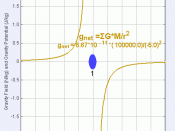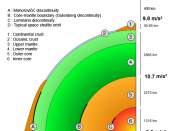Newton's Law of Universal Gravitation
Gravity if one of the four fundamental forces in the universe. Though the fundamental principles of it eluded scientists until Sir Isaac Newton was able to mathematically describe it in 1687 (Eddington 93). Gravity plays a serious part in everyday actions as it keeps everything on the ground; without gravity everything would be immobile unless a force was applied (then it would move infinitely because there would be no force to stop it).
Perhaps, the best place to start then would be with such a simple item as an apple (after all it is what 'sparked' Newton's creativity). The apple is one of the two curiosities (the other being the moon) that led Newton to discover The Law of Universal Gravitation in 1666 (Eddington 93). As Newton later wrote, it is the story of the sight of an apple falling to the ground (he was resting at Woolsthorpe because of the plague at Cambridge) that caused Newton to wonder if this same force was what held the moon in place (Gamow 41).
Newton knew that an object fell to the earth at a rate of about 9.8 meters (32 feet) per second second as pointed out by Galileo. Thus 'the apple that fell from the tree' fell to Earth at about this rate. For the first basic explanation of this we will assume a linear plane, one in which all forces act in only one direction. Therefore when the apple fell it went straight towards the center of the earth (accelerating at about 9.8 meters per second second). Newton then figured that the same force that pulled the apple to Earth also pulls the moon to the earth. But what force keeps the moon from flying into the earth or the earth flying into the...



Well researched
this is easy to understand yet displays great deatail. I loved the reference section as well, very useful.
0 out of 0 people found this comment useful.